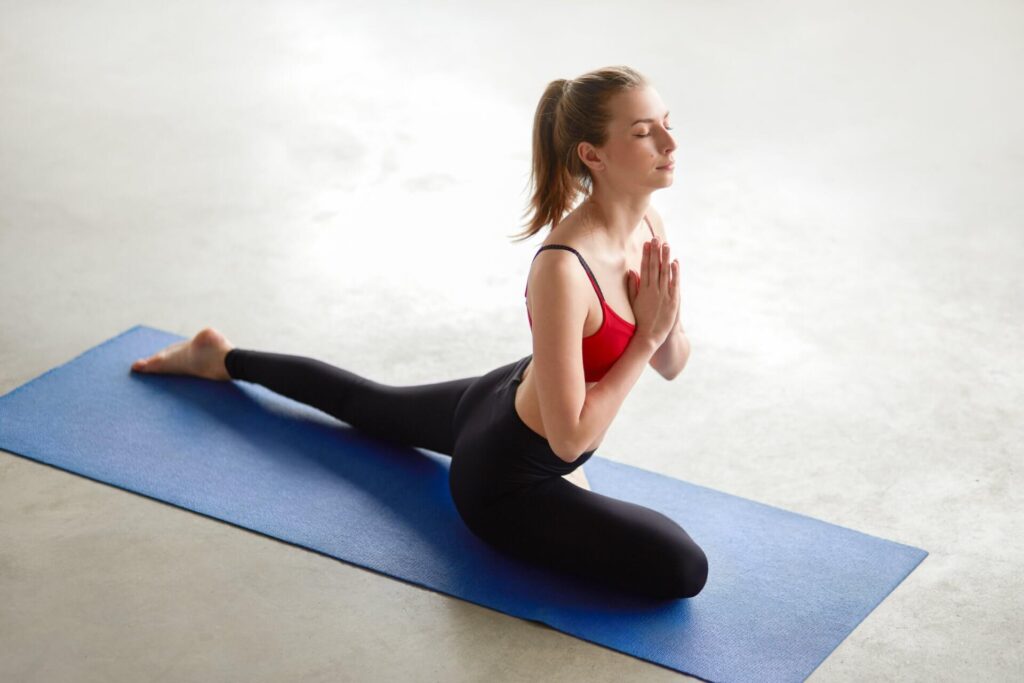“In Eka Pada Rajakapotasana, we open our hips and hearts, finding strength, flexibility, and a sense of release as we fold gracefully into the pose.” Pigeon Pose Eka Pada Rajakapotasana
Pigeon Pose, known as Eka Pada Rajakapotasana in Sanskrit, is an intermediate-level yoga posture that embodies hip opening, flexibility, and deep stretching. In this asana, practitioners bring one leg forward and bend it in front of them, while the other leg extends straight behind, creating a shape reminiscent of a pigeon. Eka Pada Rajakapotasana offers an engaging challenge for those looking to advance their yoga practice beyond the basics.
This pose is celebrated for its ability to enhance hip mobility, stretch the hip flexors, and promote a sense of physical and emotional release. It encourages both flexibility and mindfulness. Whether you’re progressing from an intermediate level or seeking to refine your practice, this comprehensive guide will introduce you to the essential techniques and alignment cues for Pigeon Pose (Eka Pada Rajakapotasana), allowing you to experience its physical and mental benefits as an intermediate practitioner.
Eka Pada Rajakapotasana Meaning
Eka Pada Rajakapotasana, or One-Legged King Pigeon Pose, combines flexibility, hip opening, and balance. The name “Eka Pada Rajakapotasana” comes from Sanskrit, signifying a one-legged king pigeon pose. In this asana, the practitioner starts in a pigeon-like position with one leg bent beneath them and extends the other leg straight behind to open the hips deeply.
Eka Pada Rajakapotasana symbolizes grace and strength, requiring flexibility in the hip flexors, quadriceps, and hamstrings, along with balance and alignment. The one-legged aspect challenges practitioners to find equilibrium in a profound stretch. This pose also encourages surrender and release, letting go of tension stored in the hips and pelvis. It emphasizes physical and emotional flexibility, inviting individuals to open their hearts and minds to new possibilities, both on and off the yoga mat.
Strengths and Benefits Pigeon Pose Eka Pada Rajakapotasana
Pigeon Pose, though of intermediate difficulty, offers numerous advantages for your physical and mental well-being:
- Hip Flexibility: It is an excellent hip opener, stretching and releasing tension in the hips.
- Lower Back Relief: The pose can help alleviate lower back discomfort and sciatic pain.
- Stress Reduction: Pigeon Pose encourages relaxation and stress reduction when practiced mindfully.
- Emotional Release: Many practitioners find emotional release in this pose, as it can be an excellent place to process and let go of stored emotions.
- Balance and Focus: It challenges your balance and focus, fostering mental clarity.
How To Do Pigeon Pose Eka Pada Rajakapotasana

Pigeon Pose Eka Pada Rajakapotasana step-by-step instructions:
- Starting Position: Begin in a tabletop position, with your wrists aligned under your shoulders and your knees under your hips.
- Bring the Knee: Slide your right knee forward toward your right wrist, positioning it behind your right hand. Your shin should be at a diagonal angle.
- Leg Position: Stretch your left leg straight back behind you. Your left toes should point directly behind you.
- Alignment: Ensure your right foot is flexed to protect the knee. Your hips should be squared, facing forward.
- Lower Torso: Lower your torso toward the ground, resting your forehead on your stacked hands or on the mat.
- Hold and Breathe: Stay in Pigeon Pose for 15-30 seconds or longer, maintaining steady breathing.
- Repeat: Repeat the pose on the other side by bringing your left knee forward and extending your right leg back.
Difficulty Level and Duration
Pigeon Pose is of intermediate difficulty and is accessible to most practitioners. The duration can vary based on your experience, but beginners may start with shorter holds and gradually extend their time in the pose.
Final Thoughts
Pigeon Pose, or Eka Pada Rajakapotasana, embodies the essence of releasing tension and finding balance. As you incorporate this intermediate pose into your practice, may you discover the physical and mental serenity it nurtures.
May Eka Pada Rajakapotasana serve as a reminder that, like the poised pigeon, you too can find grace and tranquility in your practice and in your life. With each stretch and release, may you find greater balance and a deeper sense of well-being on your self-care journey.


